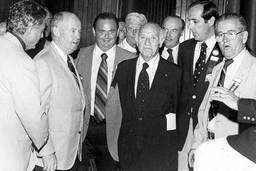I waited until this morning to post my Labor Day column, just so I could see if anyone else was writing that America’s labor movement is alive and well and doing good things for working families. It seems I have an exclusive.
Last week when the AFL-CIO hosted its annual pre-Labor Day press briefing in Washington, more than 45 reporters showed up to hear Rich Trumka roll out the labor federation’s jobs plan (it’s a good one) and announce a new SuperPac to amplify the voices of workers in our continuing all-consuming discussion, debate, and smackdown over the values of our Democracy.
When it comes to national press attention, 45 is about as good as it gets unless you’re speaking to a joint session of Congress. And it speaks truth to the corporate greedy-cats who hold the power in our country right now: Keep your guards up, dudes, America’s unions will still be on the job when Barack Obama is writing his 18th post-Presidency book of explanations and the Tea Party has been returned to its proper role as an afternoon social nicety for ladies (and gents) of a certain age.
Given what’s gone down over the last three decades, I’m surprised the labor movement as we know it even still exists. Millions of union jobs shipped overseas. Tens of thousands of workers fired for daring to organize or strike. Billions of corporate dollars spent to elect anti-union, anti-worker candidates to public office.
When I started out in the labor movement in the late 1970s, there were about 15 million union members in the United States. Three decades later, we still have about the same number. But we’ve declined dramatically as a percentage of the workforce and economic justice is still an elusive quarry for working families. Our country’s wealth gap has widened. Real wages have gone south, literally. Organized labor (what an oxymoron!) is divided over institutional allegiances as well as political ideology. And we find ourselves once again bedeviled by the neglect, even diffidence of a President we helped elect.
Still, we keep coming back, doing more than just hanging out and hanging in. We’re building more political clout through grassroots education and organizing — about a quarter of voters at the polls these days are from union families, and more than two-thirds of them vote for progressive candidates. We’re paving new roads to power with the AFL-CIO’s 3-million member community affiliate, Working America, and the new SuperPac. Union members are fighting back more aggressively than ever — public employees in Wisconsin and Ohio, the machinists taking on Boeing, those 45,000 Verizon workers making their giant employer choke on uber-greedy concession demands.
And what else is the union movement stirring up this Labor Day? Big banks are facing labor-inspired re-regulation. Employers are having to deal with a reinvigorated Department of Labor. The U.S. Chamber of Commerce is rolling out its big guns against a fair-minded National Labor Relations Board.
What I’ve learned over the years is that the labor movement is like water — you can dam it up, color it green, siphon it off, drink it, divert it, squirt it, but you can’t destroy it. It may be slowed to a trickle in Southern right-to-work states, or lolling stagnant in a decrepit big city union hall, but out in the Midwest it’s a mighty geyser, erupting on behalf of workers’ rights. In our nation’s capital, it may be dripping slowly from a broken spigot, but out in California, it’s a deep river flowing towards immigration reform. And it’s bubbling up in dozens of cities, giving life to new young worker caucuses in local unions
For taxi drivers, domestic workers and retail clerks in New York City, union values are as right as rain, nourishing new crops of organizing, even when its illegal. For agricultural workers in Florida and day laborers all across our country, the union movement provides the irrigation needed to grow new respect. Despite daily efforts to cap them off, our unions are still pipelines of justice for millions of grocery workers, health care-givers, teachers, cops, and firefighters. And they’re an ever-returning tide at the backs of workers in offices, on construction projects, in manufacturing plants and employees in public institutions, including, out in Los Angeles County, several hundred chaplains ministering to the faith needs of men and women incarcerated in otherwise unforgiving places.
Got a problem at work? Need a raise? Wanna terminate the career of a Member of Congress who’s trying to slide you down the tube from underpaid to unemployed? Try a percentage play and join a union. Then open your umbrella.
This post originally appeared at From the Left Bank of Potomac, Ray Abernathy’s blog.







